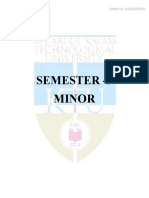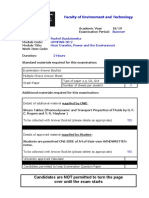CW Sana M3H824741 Feb 2022 - Modified
CW Sana M3H824741 Feb 2022 - Modified
Uploaded by
nickCopyright:
Available Formats
CW Sana M3H824741 Feb 2022 - Modified
CW Sana M3H824741 Feb 2022 - Modified
Uploaded by
nickOriginal Description:
Original Title
Copyright
Available Formats
Share this document
Did you find this document useful?
Is this content inappropriate?
Copyright:
Available Formats
CW Sana M3H824741 Feb 2022 - Modified
CW Sana M3H824741 Feb 2022 - Modified
Uploaded by
nickCopyright:
Available Formats
F/QAP/021/001
College of Engineering
Name of the programme BEng Process Operations and Maintenance
Name of Module with Code Chemical Engineering Thermodynamics and Reaction
Kinetics, M3H824741
Level/Semester & AY Level 3, Semester B, 2021 - 2022
Course coordinator Dr Saravanan A M
Coursework Type Assignment
Assessment weightage 30%
Type and date of submission Online submission on 2nd May 2022
Aim To provide an understanding of the underlying principles of
Thermodynamics and reaction kinetics required for a
process engineer.
Learning Outcomes 1. Explain and analyse isothermal, isobaric, isochoric,
isentropic and cyclic processes for an ideal gas.
2. Analyse steam power and refrigeration cycles.
3. Analyse the reaction kinetics and behaviour of
reactors under various operating conditions to find
the rate expression.
4. Explain suitable applications of chemical reactors
relevant to process industries and analyse the
appropriate criteria for reactor selection.
Task
Answer all the Questions
Note : Each student will be given different data to perform the CW individually.
1. Consider an ideal gas undergoing a series of three operations as given below:
a) The gas is heated at constant volume from 300 K and 1 bar to a pressure
of 2 bar.
b) It is expanded in a reversible adiabatic process to a pressure of 1 bar.
c) It is cooled at constant pressure of 1 bar to 300 K.
Determine the heat and work effects for each step. Assume Cp = 29.3 kJ/ kmol K.
[25 marks]
Solution:
QEAD Rev:03 ver 01 9 th July 2017 Template A 1
F/QAP/021/001
2. Thermodynamics is the study of the relations between heat, work, temperature, and
energy. The laws of thermodynamics describe how the energy in a system change and
whether the system can perform useful work on its surroundings. Choose any
equipment or unit in the process plant which undergoes the thermodynamics changes.
Highlight the (1) importance, (2) thermodynamically features of the unit and (3) define a
numerical problem along with appropriate solution with suitable assumption. (1500
words).
[25 marks]
3. Plug flow reactors, mixed flow reactors and Batch reactors are widely used in chemical
and process industries. Select any one among these reactors and derive the design
equation with appropriate assumptions and a neat diagram. Also discuss the pros and
cons of these reactors and suggest a suitable one for the production of ethanol.
[1500 words]
[25 marks]
4. a) A reversible process is never attained in practice. It can only be approached. What
are the factors that make this statement true ? [250 words] [5
marks]
b) Mixtures of n-heptane (A) and n-Octane (B) are expected to behave ideally. The total
pressure over the system is 101.3 kPa. Using the vapour pressure data given below (a)
construct the boiling point diagram and (b) equilibrium diagram.
Temperature 371.4 378 383 388 393 398.6
(K)
PA, kPa 101.3 125.3 140.0 160.0 179.9 205.3
PB, kPa 44.4 55.6 64.5 74.8 86.6 101.3
[20 marks]
QEAD Rev:03 ver 01 9 th July 2017 Template A 2
F/QAP/021/001
Instructions
1. Please note that suggestions for further readings related to the theory part are contained
within the module handbook. These reading lists are not exhaustive and candidates are
encouraged to read further to expand their understanding and knowledge of operating
parameters involved in the lab exercises.
2. Plagiarism is a serious offence. In case of any plagiarism detected, penalty will be
imposed leading to zero mark. Policy and guidelines for dealing with plagiarism and
malpractice in examination can be viewed by clicking:
http://coeportal.nu.edu.om/member/contentdetails.aspx?id=490
3. The course work shall be subject to plagiarism software check before uploading in
Blackboard.
4. Course work should be submitted in time. Late submission is subjected to the college
guidelines on late submission of coursework and can be viewed by clicking:
http://coeportal.nu.edu.om/member/contentdetails.aspx?id=565
5. Name, student identification to be written clearly and legibly on the cover page to be
uploaded by online in the Blackboard.
SUBMISSION OF COURSEWORK
The coursework should be submitted online through the Blackboard. For online
submission and evaluation, word document file with appropriate cover page mentioning
the name of the students, student number and title of the course work should be
uploaded using the submission link created and made available by the Course Leader.
The Safe assign report should be attached to the submitted work. Marks will be awarded
to each student individually.
Marking scheme
Question Description Weightage Total weightage
No (%) (%)
1 Understanding of the problem with suitable 10% 25
steps
Detailed solution with final answer 15%
2 Importance and Thermodynamical features 15%
Problem interpretation, identification of data 10% 25
and solution
3 Understanding of ideal reactor and 15%
performing design equations 25
Comparison of ideal reactors and suggestion 10%
with rationale
4(a) Understanding of the problem with suitable 10% 5
steps
Detailed solution with final answer 10%
4(b) Justification with examples 5% 20
QEAD Rev:03 ver 01 9 th July 2017 Template A 3
F/QAP/021/001
Total 100% 100 marks
Referencing
Harvard Referencing (CCE Style) First Edition 2013 should be followed for both in-text and
listing references. This downloadable document can be found in our CCE portal at:
http://coeportal.nu.edu.om/member/contentdetails.aspx?id=693
Name and Signature of Module leader
Dr Saravanan Date: 16th February 2022
QEAD Rev:03 ver 01 9 th July 2017 Template A 4
You might also like
- Bohai 2 Oil Rig AccidentDocument3 pagesBohai 2 Oil Rig Accidentnick100% (1)
- COMSATS University Islamabad, Lahore Campus: Assignment 1 - Chemical Reaction Engineering SP-2021Document1 pageCOMSATS University Islamabad, Lahore Campus: Assignment 1 - Chemical Reaction Engineering SP-2021Samaha FatimaNo ratings yet
- CHT305 SyllabusDocument8 pagesCHT305 SyllabusYuxin CasioNo ratings yet
- College of Engineering and Build EnvironmentDocument5 pagesCollege of Engineering and Build EnvironmentebrahimNo ratings yet
- Bakhshan2008bDocument9 pagesBakhshan2008bwaheed -ur-rehmanNo ratings yet
- CHE522 - CPS Assignment - Dec23 - V2 - StudentDocument4 pagesCHE522 - CPS Assignment - Dec23 - V2 - Studentroseuuuuuu.uNo ratings yet
- Scrubber DesignDocument26 pagesScrubber DesignVital sardharaNo ratings yet
- Assignments 2024Document5 pagesAssignments 2024sray02051No ratings yet
- 1974Document20 pages1974Deneme YanılmaNo ratings yet
- 4 - Sun T Et Al - 2023 - Cooling Performance and Optimization of A Tubular Indirect EvaDocument9 pages4 - Sun T Et Al - 2023 - Cooling Performance and Optimization of A Tubular Indirect Evadaianedias.ifnmgNo ratings yet
- Tüm NotlarDocument1,271 pagesTüm NotlarGöksel VATANNo ratings yet
- 22-What Happens in A Catalytic Fixed-Bed Reactor For N-Butane Oxidation ToDocument13 pages22-What Happens in A Catalytic Fixed-Bed Reactor For N-Butane Oxidation Toali1860No ratings yet
- Homework 2 - 202881 - 01 - SentDocument3 pagesHomework 2 - 202881 - 01 - SentDavid E. MuñozNo ratings yet
- CHEMICAL ENGINEERING 2019 Scheme S4 Syllabus Ktustudents - inDocument88 pagesCHEMICAL ENGINEERING 2019 Scheme S4 Syllabus Ktustudents - inJOSEPH SABU 190782No ratings yet
- Waste To Energy Conversion Technology Course Code: 4350502: Page 1 of 8Document8 pagesWaste To Energy Conversion Technology Course Code: 4350502: Page 1 of 8Cliches in0% (1)
- MET303 - Ktu QbankDocument16 pagesMET303 - Ktu QbankANAND V VNo ratings yet
- 1-s2.0-S0009250921007296-mainDocument8 pages1-s2.0-S0009250921007296-mainBüşra BalcıNo ratings yet
- MEC 309 OutlineDocument4 pagesMEC 309 OutlineBob jonesNo ratings yet
- CENG0005 - Proj - 2022 - With Cover SheetDocument6 pagesCENG0005 - Proj - 2022 - With Cover SheetGary Gary xuNo ratings yet
- 01 Ee044 3 3 THT Ia QPDocument7 pages01 Ee044 3 3 THT Ia QPMohamed AltijaniNo ratings yet
- AT Manual Back To Back Print PDFDocument97 pagesAT Manual Back To Back Print PDFAvinash UgaleNo ratings yet
- Optimization ProblemsDocument6 pagesOptimization Problemsneft0% (1)
- Faculty of Mechanical EngineeringDocument4 pagesFaculty of Mechanical EngineeringHuzaifa RehanNo ratings yet
- CHT301 - Ktu QbankDocument10 pagesCHT301 - Ktu QbankYuxin CasioNo ratings yet
- Chemical EngineeringDocument9 pagesChemical EngineeringanushafiNo ratings yet
- Chemical Engineering - Dynamic Modelling of Batch Reactor PDFDocument25 pagesChemical Engineering - Dynamic Modelling of Batch Reactor PDFBellota03No ratings yet
- Lederer 2000Document8 pagesLederer 2000ram shyamNo ratings yet
- CRELect1 - Mole BalancesDocument32 pagesCRELect1 - Mole BalancesNURUL YAHSIFAH SYQELLA BINTI YAHYA BK21110100No ratings yet
- EIE315 Course Learning OutcomeDocument3 pagesEIE315 Course Learning OutcomeBruhNo ratings yet
- UFMFW8-30-2 Exam Paper 18 - 19 SummerDocument7 pagesUFMFW8-30-2 Exam Paper 18 - 19 SummerAdnan RajaNo ratings yet
- Basic Thermodynamics (BTME-305-18)Document14 pagesBasic Thermodynamics (BTME-305-18)Surjit Kumar GandhiNo ratings yet
- AspenPlus ProjectDocument20 pagesAspenPlus ProjectMahesh ShirsathNo ratings yet
- Performance Analysis of A Pebble Bed Air Heater Using CFD TechniqueDocument64 pagesPerformance Analysis of A Pebble Bed Air Heater Using CFD TechniquevenkatesananushatkuNo ratings yet
- Summer 2024Document17 pagesSummer 2024Mayur JadhavNo ratings yet
- 1 s2.0 S0263876224002958 MainDocument20 pages1 s2.0 S0263876224002958 Mainch20b100No ratings yet
- Hamdard University, FEST North Nazimabad Campus Final Examination, Fall - 2020Document2 pagesHamdard University, FEST North Nazimabad Campus Final Examination, Fall - 2020Zain AliNo ratings yet
- Project - Description - S1 - 2024 - CHEN3010Document5 pagesProject - Description - S1 - 2024 - CHEN3010KHÁNH VÂN DIỆPNo ratings yet
- BTP 1 Report Arghadeep 21CH30049Document26 pagesBTP 1 Report Arghadeep 21CH30049Arghadeep BiswasNo ratings yet
- ENGINEERING THERMODYNAMICS12345Document10 pagesENGINEERING THERMODYNAMICS12345adithya dasNo ratings yet
- Lamp AnalysisDocument6 pagesLamp AnalysisSuraj MulayNo ratings yet
- Assignment 2 - Heat ExchangerDocument4 pagesAssignment 2 - Heat Exchangerlaivernteng63No ratings yet
- Semester 3 Assignments 2024Document17 pagesSemester 3 Assignments 2024sray02051No ratings yet
- Ijee 1045Document11 pagesIjee 1045ary.engenharia1244No ratings yet
- Hababneh@zu Edu JoDocument3 pagesHababneh@zu Edu JoRaed IzzatNo ratings yet
- CEPD101 Study Guide For 2024Document14 pagesCEPD101 Study Guide For 2024Sydney Jaydean KhanyileNo ratings yet
- Shevchenko 2017 J. Phys. Conf. Ser. 891 012255Document7 pagesShevchenko 2017 J. Phys. Conf. Ser. 891 012255senthilNo ratings yet
- VDOE Sample Science Performance Assessment: Content StandardsDocument7 pagesVDOE Sample Science Performance Assessment: Content StandardsReuben John AbalayanNo ratings yet
- Chemical ngày maiDocument46 pagesChemical ngày maingocthanh2821No ratings yet
- 58203-mt - Process Modelling and SimulationDocument2 pages58203-mt - Process Modelling and SimulationSRINIVASA RAO GANTANo ratings yet
- Chemical and Materials Engineering Department: Course SyllabiDocument35 pagesChemical and Materials Engineering Department: Course SyllabiAbdullah SalemNo ratings yet
- Petrova 2021 J. Phys. - Conf. Ser. 2052 012033 PDFDocument8 pagesPetrova 2021 J. Phys. - Conf. Ser. 2052 012033 PDFmahmoud mostafaNo ratings yet
- 22566 -2022-Winter-model-answer-paperDocument21 pages22566 -2022-Winter-model-answer-paperganesh MoreNo ratings yet
- OE 4th Class CE Guideline Effective June 15 2021 Final v.1Document8 pagesOE 4th Class CE Guideline Effective June 15 2021 Final v.1Sahil KariyaNo ratings yet
- FIRST NOTES January 2021Document37 pagesFIRST NOTES January 2021vivaline AchiengNo ratings yet
- Bmmd2313 2021 Fluid Mechanics AssignmentDocument6 pagesBmmd2313 2021 Fluid Mechanics AssignmentThaneswaran BaluNo ratings yet
- RANKINEDocument18 pagesRANKINEGabi OtakuNo ratings yet
- 1 Green-EngDocument3 pages1 Green-EngShanu KumarNo ratings yet
- Applied Thermodynamics LabDocument3 pagesApplied Thermodynamics Labnavneetkpatil8409No ratings yet
- Membrane Reactor Engineering: Applications for a Greener Process IndustryFrom EverandMembrane Reactor Engineering: Applications for a Greener Process IndustryNo ratings yet
- Biomass as a Sustainable Energy Source for the Future: Fundamentals of Conversion ProcessesFrom EverandBiomass as a Sustainable Energy Source for the Future: Fundamentals of Conversion ProcessesNo ratings yet
- Bishara PPT O2Document3 pagesBishara PPT O2nickNo ratings yet
- PPT01Document4 pagesPPT01nickNo ratings yet
- CW1 Upload01Document30 pagesCW1 Upload01nickNo ratings yet
- AnswersDocument19 pagesAnswersnickNo ratings yet
- RT PicsDocument8 pagesRT PicsnickNo ratings yet
- PE 423 Assignment IDocument20 pagesPE 423 Assignment InickNo ratings yet
- JoyfulnessDocument1 pageJoyfulnessnickNo ratings yet



































































